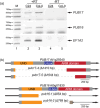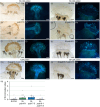Investigating a role for PUB17 and PUB16 in the self-incompatibility signaling pathway in transgenic Arabidopsis thaliana
- PMID: 39044900
- PMCID: PMC11263811
- DOI: 10.1002/pld3.622
Investigating a role for PUB17 and PUB16 in the self-incompatibility signaling pathway in transgenic Arabidopsis thaliana
Abstract
In Brassicaceae self-incompatibility (SI), self-pollen rejection is initiated by the S-haplotype specific interactions between the pollen S cysteine-rich/S-locus protein 11 (SCR/SP11) ligands and the stigma S receptor kinases (SRK). In Brassica SI, a member of the Plant U-Box (PUB) E3 ubiquitin ligases, ARM-repeat containing 1 (ARC1), is then activated by SRK in this stigma and cellular events downstream of this cause SI pollen rejection by inhibiting pollen hydration and pollen tube growth. During the transition to selfing, Arabidopsis thaliana lost the SI components, SCR, SRK, and ARC1. However, this trait can be reintroduced into A. thaliana by adding back functional copies of these genes from closely related SI species. Both SCR and SRK are required for this, though the degree of SI pollen rejection varies between A. thaliana accessions, and ARC1 is not always needed to produce a strong SI response. For the A. thaliana C24 accession, only transforming with Arabidopsis lyrata SCR and SRK confers a strong SI trait (SI-C24), and so here, we investigated if ARC1-related PUBs were involved in the SI pathway in the transgenic A. thaliana SI-C24 line. Two close ARC1 homologs, PUB17 and PUB16, were selected, and (Clustered Regularly Interspaced Short Palindromic Repeats (CRISPR)/CRISPR-associated protein 9 (Cas9) technology was used to generate pub17 and pub16 mutations in the C24 accession. These mutants were then crossed into the transgenic A. thaliana SI-C24 line and their potential impact on SI pollen rejection was investigated. Overall, we did not observe any significant differences in SI responses to implicate PUB17 and PUB16 functioning in the transgenic A. thaliana SI-C24 stigma to reject SI pollen.
Keywords: ARC1; Arabidopsis; Brassica; PUB16; PUB17; SRK; self‐incompatibility.
© 2024 The Author(s). Plant Direct published by American Society of Plant Biologists and the Society for Experimental Biology and John Wiley & Sons Ltd.
Conflict of interest statement
The authors did not report any conflict of interest.
Figures





Similar articles
-
The ARC1 E3 ligase gene is frequently deleted in self-compatible Brassicaceae species and has a conserved role in Arabidopsis lyrata self-pollen rejection.Plant Cell. 2012 Nov;24(11):4607-20. doi: 10.1105/tpc.112.104943. Epub 2012 Nov 30. Plant Cell. 2012. PMID: 23204404 Free PMC article.
-
A conserved role for the ARC1 E3 ligase in Brassicaceae self-incompatibility.Front Plant Sci. 2014 May 5;5:181. doi: 10.3389/fpls.2014.00181. eCollection 2014. Front Plant Sci. 2014. PMID: 24847339 Free PMC article. Review.
-
Exploring the role of a stigma-expressed plant U-box gene in the pollination responses of transgenic self-incompatible Arabidopsis thaliana.Plant Reprod. 2014 Jun;27(2):59-68. doi: 10.1007/s00497-014-0240-4. Epub 2014 Feb 28. Plant Reprod. 2014. PMID: 24573467
-
Functional test of Brassica self-incompatibility modifiers in Arabidopsis thaliana.Proc Natl Acad Sci U S A. 2011 Nov 1;108(44):18173-8. doi: 10.1073/pnas.1115283108. Epub 2011 Oct 24. Proc Natl Acad Sci U S A. 2011. PMID: 22025723 Free PMC article.
-
Commonalities and differences between Brassica and Arabidopsis self-incompatibility.Hortic Res. 2014 Oct 29;1:14054. doi: 10.1038/hortres.2014.54. eCollection 2014. Hortic Res. 2014. PMID: 26504553 Free PMC article. Review.
References
-
- Acosta, M. , Ahumada, M. , Lassaga, S. , & Casco, V. (2012). PUB16 gene expression under abiotic stress and their putative role as an ARM repeat protein in Arabidopsis thaliana self‐pollination pathway. Advances in Bioscience and Biotechnology, 3, 609–619. 10.4236/abb.2012.35079 - DOI
-
- Beuder, S. , Dorchak, A. , Bhide, A. , Moeller, S. R. , Petersen, B. L. , & MacAlister, C. A. (2020). Exocyst mutants suppress pollen tube growth and cell wall structural defects of hydroxyproline O‐arabinosyltransferase mutants. The Plant Journal, 103, 1399–1419. 10.1111/tpj.14808 - DOI - PMC - PubMed
LinkOut - more resources
Full Text Sources
Research Materials

